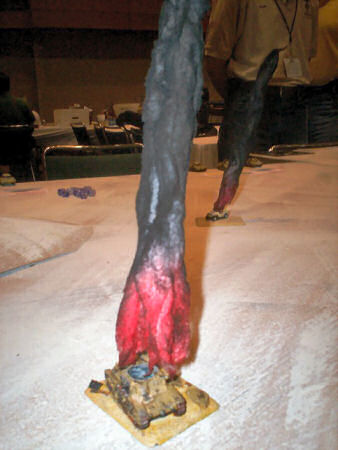Sue Wachowski - Hair and Skin
I took two classes from Sue. Both of hers were very hands-on, in that she had us working on a miniature, while she would come around and critique or make suggestions. Another nice touch was that she provided some prepared notes to take back with us.
The first class was on how to paint hair and skin, but we spent a majority of the time on painting hair. Sue's approach to this is straightforward, but takes some time to get it right.
Look at the miniature from the direction of the light source. In most cases, that will be from directly above. Find the areas on the hair that you can see from this position, and these will be where the highlights fall.
Now you are ready to start. Paint the hair with your base color, and then slowly blend it up to where the highlights are supposed to be. Don't worry about strands of hair right now, treat the area like you would a helmet.
Yep, thatís right, don't wash or worry about the indentations in the hair.
One of the mantras I got from this class was higher highlights, darker darks! In other words, make the differences even more stark than you would think would be enough. Once you have the highlights where you want them, take your basecoat or an intermediate color and make a glaze from it. The glaze should not be as thin as a wash. Use the glaze over the entirety of the hair, with the goal of making the blends smooth, and place it on the miniature by following the flow of the hair.
Once this is accomplished, then focus on several of the strands of hair that can be hit lightly with highlights. Place the highlights along the flow of the strands of hair. That's it!
Sue showed us a number of ways to use this technique, and it works well across a wide range of color types (even blues, greens, and so on). Furs can be done with the same technique. We did not get to discuss faces much, as we dwelt a lot on hair.
Sue Wachowski - Feathering and Glazing
The second class focused on another way to do blends. Here, we worked mainly on cloaks and large areas that require smooth blending.
Sue has you put on a basecoat that is usually the darkest color. You then blend up from this to the highlights. We were coached to only do a section of the cloak at a time, so as not to lose focus and to keep from getting our paint mixtures out of balance. Unlike in another class, we did not necessarily have separate sections for our colors (from dark to light), but mixed them by eye as we went along - from two or three spots on the palettes (OK, the styrofoam plates we were using....)
Again, Sue emphasized keeping the paints thin, and adding flow improver or water where necessary. When we applied the paint from dark to light, Sue said we should use a crosshatching technique. Go from one end to the other of the area you are working on, at an angle to the flow of the shading, and then go back over the painted area with a reverse angle to the first one - so it mentally feels like you have painted a series of X's along the folds. Nice technique and works quite well.
Once the blending is finished, she suggested using a mid-color or lighter glaze along the lines of the folds to smooth out the transitions.
These were two very beneficial classes for me.









